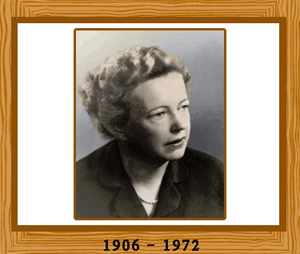The German physicist and mathematician, Maria Goeppert-Mayer is prominent for her numerous contributions to the field of physics which earned her a Nobel Prize in Physics in 1963. She was the first woman to win the Nobel Prize for theoretical physics and second woman in history to win a Nobel Prize—the first being Marie Curie. She is most famous for proposing the nuclear shell model of the atomic nucleus.Early Life and Career:

Maria Goeppert Mayer was born on June 28, 1906, Kattowitz, Germany (now Katowice, Poland). She was the only child of Friedrich Goeppert, a progressive professor of pediatrics at the University at Göttingen and Maria nee Wolff, a former music teacher. When she was very young her family moved to Göttingen in 1910, where Maria was educated at a girls’ grammar school operated by suffragettes. The school went bankrupt after her junior year, but she passed a collegiate examination without a high school diploma and earned her PhD under Max Born at the University of Göttingen in 1930. The same year she married Dr. Joseph Edward Mayer, an assistant of James Franck. After marriage they both moved to United States.
Women during that time were generally regarded unsuitable in the upper realms of academia, and despite her doctorate for years she was largely limited to unpaid and unofficial work in university laboratories, her presence only accepted because her husband. In the following few years, Goeppert-Mayer worked at unofficial or volunteer positions, initially at the Johns Hopkins University in Baltimore, Maryland, from 1931–39, then Columbia University in 1940-46, and after that the University of Chicago. Later she also took different positions that came her way: a teaching position at the Sarah Lawrence College, a research position with Columbia University’s Substitute Alloy Materials Project and with the Opacity Project. She also spent some time at the Los Alamos Laboratory.
During her husband’s time at the University of Chicago, Goeppert-Mayer volunteered to become an Associate Professor of Physics at the school. Within a few months of her arrival, when the nearby Argonne National Laboratory was founded on July 1, 1946, Goeppert-Mayer was offered a part-time job there as a Senior Physicist in the Theoretical Physics Division. This was the first time in her career that she was working and paid at a level commensurate with her training and expertise. Two years later she made the breakthrough that earned her tremendous fame and respect in her field.
During 1960, Goeppert-Mayer was appointed to a position as a (full) Professor of Physics at the University of California at San Diego.
Development of the Structure of Nuclear Shells:
It was during her time at Chicago and Argonne that she developed a mathematical model for the structure of nuclear shells. With Edward Teller (one of her colleagues at Argonne National Laboratory) she conducted inquiries about the source of the elements, and noticed the repetition of seven “magic numbers”, as she named them — 2, 8, 20, 28, 50, 82, and 126. Elements with a “magic number” of protons or neutrons were consistently more stable than elements with other numbers of protons or neutrons. On the basis of this, she proposed in that inside the nucleus, protons and neutrons are arranged in a series of nucleon layers, like the layers of an onion, with neutrons and protons rotating around each other at each level. During the same time but working independently, German physicist J. Hans D. Jensen reached the same conclusion.
Goeppert-Mayer was awarded the Nobel Prize in Physics in 1963, shared with J. Hans D. Jensen and Eugene Paul Wigner for their proposal of the shell nuclear model.
Death:
Goeppert-Mayer died due to a heart failure in San Diego, California, on February 20, 1972.




.jpg)









